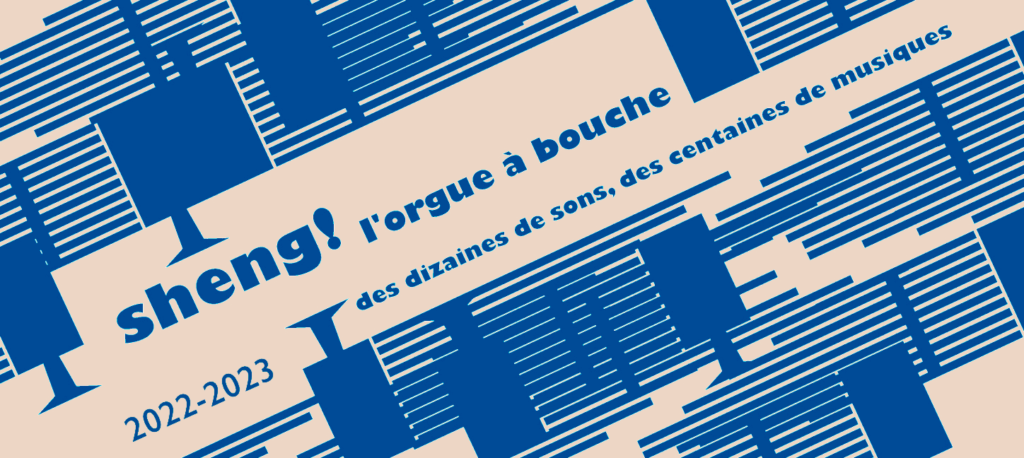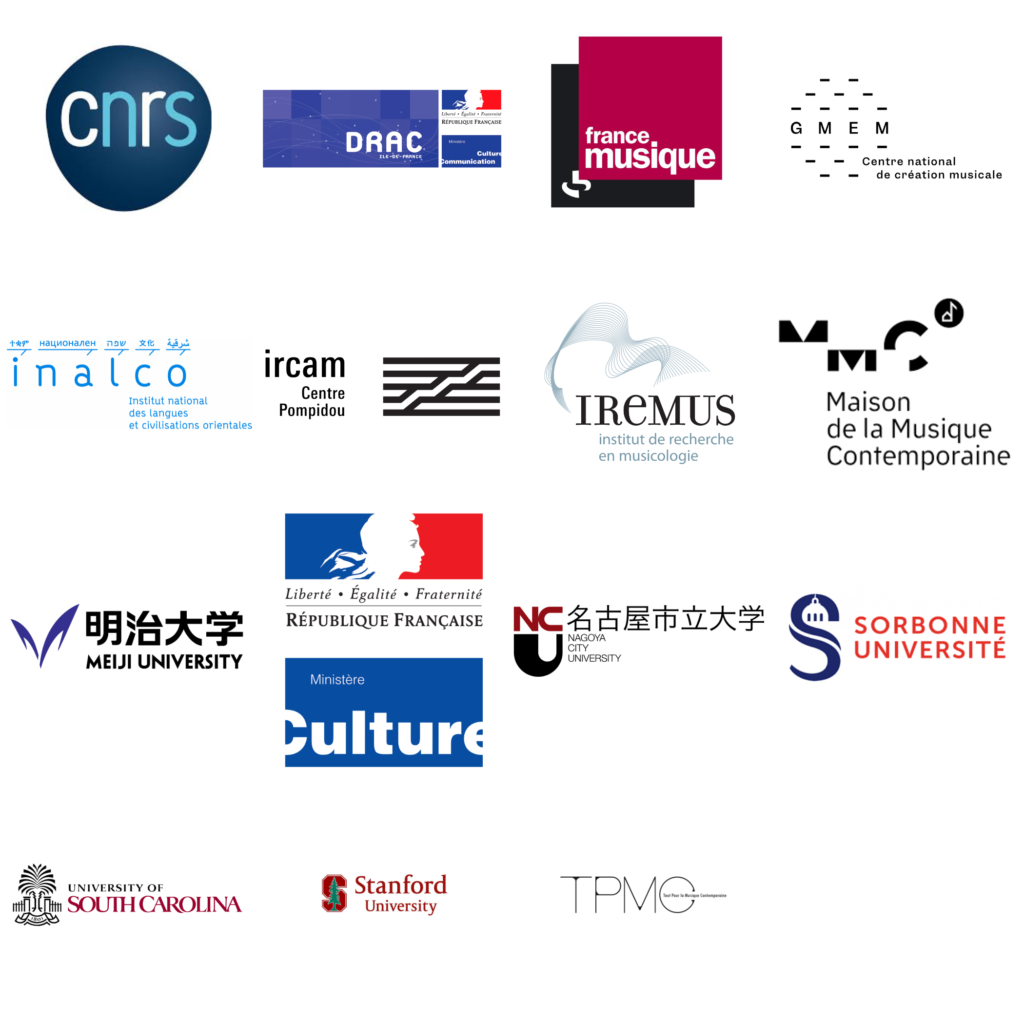
Jean-Marc Chouvel (Sorbonne Université, IReMus)
Pierre Couprie (Université d’Évry / Université Paris-Saclay)
Liao Lin-Ni (TPMC – IReMus)
Mikhail Malt (IRCAM – IReMus)
François Picard (Sorbonne Université, IReMus)
Liao Lin-Ni, Direction of Research “sheng! l’orgue à bouche”
[ SEMINAR 16 ]
Tuesday, 14 March 2023 l 14:30- 17:30 l Salle Stravinsky, IRCAM (1 Place Igor Stravinsky, 75004 Paris) & Ircam YouTube Channel
Fang Man 方滿 (University of South Carolina): ** Color, Birdsongs, and Symmetry – Concertos for Sheng and Orchestra
The solo instrument Sheng is the world’s oldest free-reed mouth organ, with a history of more than 3,000 years. It is a representation of 凤凰 (fenghuang) Phoenix, 和 (he) Harmony, and 笙 (sheng) – 生 life. The idea of this work came from maestro Esa-Pekka Salonen’s initial proposal to pair a piece of mine with Scriabin’s Prometheus. Song of the Flaming Phoenix was composed using inspiration of the symmetric octatonic sets and the color schemes of Prometheus. The Fenghuang, known as the Phoenix, was considered the king of all birds in Chinese mythology. In the latter half of Song of the Flaming Phoenix, with computer-assisted orchestration program Orchidea designed by Dr. Carmine Emanuele Cella (UC-Berkeley), I translated the birdsongs heard in my backyard in South Carolina into seven other mythical birds: Yu (Carolina Chickadee), Changfu (Carolina Wren), Manman (Yellow-Rumped Warbler), Luan (Tufted Titmouse), Lingyao (Northern Cardinal & Summer Tanager), Qiyu (Red-breasted Nuthatch & Northern Mockingbird), and Min (Blue-gray Gnatcatcher). I imagine that the Fenghuang lead her feathered friends from heaven to save humanity from the ongoing disasters. Thanks to the devotion and artistry of Sheng virtuoso Wu Wei, we explored expansive ranges of harmony, timbre as well as rhythmic diversities on this ancient instrument.
François Picard (Sorbonne Université – IReMus) : * Analyse génétique de quelques versions du “Chaoyuan ge”
“Chaoyuan ge” (Court song) from Kunqu song to solo sheng, from Gao Lian (1573) to Yu Zhenfei (1953) via Wang Jinlie (1924), then from Chen Zhong (1960) to Xu Chaoming (1998) via François Picard (1995), and from Xu to Weng Zhenfa (2015).
________________________________
Co-Organisation: TPMC – Tout Pour la Musique Contemporaine – IRCAM
Partners : IReMus – Institut de Recherche en Musicologie, CNRS, Sorbonne Université, University of South Carolina School of Music and DRAC Ile-de-France
________________________________
[ SEMINAR 17 ]
Tuesday, 4 April 2023 l 14:30- 17:30 l Salle Stravinsky, IRCAM (1 Place Igor Stravinsky, 75004 Paris) & Ircam YouTube Channel
Véronique Brindeau (Inalco): * Shô, shô basse et sheng alto dans Anâhata (1986) de Jean-Claude Eloy
Anahâta – “Primordial Vibration” – is an electronic fresco composed between 1984 and 1986 by Jean-Claude Eloy. Conceived as a triptych, the work combines an electronic score with two solo voices of Buddhist monks, percussion instruments and the wind instruments of gagaku court music: ryûteki transverse flute, hichiriki oboe and shō mouth organ, the latter forming the fulcrum of the third part subtitled Nimîlana-Unmîlana (“That which opens – that which folds”). It is this part, which also makes use of the ô shō and the sheng-alto, that will be analysed. Like many of his other works for electronics and voice or instruments of oriental origin, it is a question for the composer, who has always been concerned by the slow and fluctuating tempo of gagaku and by the slippery chanting in indeterminate pitches of Buddhist shômyô, of “broadening his cultural roots” – while at the same time enlarging the traditional palette of the gagaku by the addition of the ô hichiriki (the lower fourth of the hichiriki) and of the ô shō (lower octave of the shō). As he writes: “From this dialectic between these two great sources (“the oriental” and “the occidental”) was born my entire approach as a composer.
Mikako Mizuno 水野 みか子 (Nagoya City University): ** Sho, Gagaku and modern harmony in Yoritsune Matsudaira (1907-2001) – interpolarity between harmony and timbre
Yoritsune Matsudaira (1907-2001) is the first Japanese composer who combined occidental instruments with gagaku harmony and crystalized to own personal sound ecriture. Theme and variations for piano and orchestra (1951) showed very special approach to twelve tone technique and the style of the piece is far from atonal harmony. It partially simulates Aitake harmony as cluster. Matsudaira was thinking gagaku sound is different from gagaku harmony and from the instrumental timbre of gagaku. Matsudaira often used six violins for the sound of Aitake in his early days but had never used sho itself before 1990’s. Matsudaira often claimed that he didn’t use Japanese instruments like sho or koto because their timbre inevitably evokes Japanese culture and aesthetics.
For Matsudaira, gagaku is not the counterpart to be simulated but a metaphysical world to be pursued through musical experiments.
Encountering with Yumi Nara’s singing style with much portamento triggered new phase of Matsudaira’s composition. Genji Mnogatari, mono -opera dedicated to Yumi Nara, was premiered in 1995 in Fukui. On the stage, five modern pictures by Toshimitsu Imai were presented by turns. There included soprano, two shō (one of them is U) and So, which is very rare case in Matsudaira’s compositions.
________________________________
Co-Organisation: TPMC – Tout Pour la Musique Contemporaine – IRCAM
Partners : IReMus – Institut de Recherche en Musicologie, CNRS, Sorbonne Université, Nagoya City University, Meiji University and DRAC Ile-de-France
________________________________
[ SEMINAR 18 ]
Thursday, 11 May 2023 l 14:30- 17:30 l Salle Stravinsky, IRCAM (1 Place Igor Stravinsky, 75004 Paris) & Ircam YouTube Channel
Wataru Miyakawa (Meiji University): * Les langages musicaux inspirés du shō chez Tōru Takemitsu et Toshio Hosokawa
This seminar aims to investigate the relationship between the shō mouth organ and the musical languages of Tōru Takemitsu and Toshio Hosokawa.
The shō is an instrument that has fascinated many Japanese composers, including Takemitsu and Hosokawa. Both composers composed for shō, but they also developed musical languages based on the sound of this instrument. More specifically, aitake (harmonies played by the shō in classical gagaku) is an important element in the development of their harmonic languages. From this point of view, Landscape (1960) for string quartet and The Dorian Horizon (1966) for seventeen strings are Takemitsu’s two most important works, as one of the fundamental ideas of these works lies in the simulation of the shō by the string instruments. Hosokawa’s use of the shō-influenced harmonic language is more systematized, as in most of his works he uses the ‘mother chord’ that he devised based on both the sound of the aitake and the work of Anton Webern.
Chong Kee Yong 鍾啟榮 (composer): ** Inspiration and practice brought about to my compositions for traditional 37-reed soprano Sheng by the multi-cultural society of Asia and modern music of the West
After years of exposing myself to both Eastern and Western cultures, I have gradually found the music world of my own. My experience of studying in Europe for years offered me a different perspective to look into the eastern culture that is familiar yet negligible at times.
A large number of master pieces from East and West inspired me to respect and learn from traditional art and cultures so that I could compose music in my own way which covers new interpretation but nevertheless, still carries my own traditional elements. Many of my works emphasizes on the melodic and narrative natures of Asian music. So in my lecture, I will be talking about several of my works which I composed for 37-reed Sheng through many years of the close collaboration and specially composed for Sheng maestro Mr. Wu Wei. In these works which is show the originality, various Asia traditional multi-cultural elements, and how I carry forward the drama, philosophy, etiquette and spirit of the traditional music.
________________________________
Co-Organisation: TPMC – Tout Pour la Musique Contemporaine – IRCAM
Partners : IReMus – Institut de Recherche en Musicologie, CNRS, Sorbonne Université, DRAC Ile-de-France and Meiji University
________________________________
[ SEMINAR 19 ]**
Thursday, 1 June 2023 l 14:30- 17:30 l Salle Stravinsky, IRCAM (1 Place Igor Stravinsky, 75004 Paris) & Ircam YouTube Channel
Julie Zhu (Stanford University), Alexis Baskind (musician, sound engineer and RIM) and Wu Wei (musician of sheng): Forest of bamboos – Sum and Difference by Julie Zhu
For the vast majority of studio or concert productions, the sheng (like most instruments) is usually presented as an external sound object to the listener, i.e. a sound source, typically positioned at the front, with a given width and distance, placed in a real or virtual space.
In order to explore and present the sheng in a new way, “A Bamboo Forest: The 37-pipe sheng presented from the inside”, born from empirical research between Wu Wei and Alexis Baskind, proposes a reversal of perspective. It places the listener metaphorically inside the sheng, surrounded by the pipes, in a way similar to the image of “forest of pipes” sometimes used for the church organ. This idea, which for the organ may be technically easier (though still complex) to implement, poses significant challenges for the sheng because of the size of the instrument and the radiation of the pipes (mostly directed outside of the instrument). It is therefore necessary to look for alternative methods of designing a microphone system to overcome these difficulties.
The multidisciplinary project “Forêt de Bambous” takes place in several steps between 2020 and 2024. This year in 2023, we will present the second step of research and creation of a new work by Julie Zhu commissioned by Radio France for “Création Mondiale” (production: Anne Montaron). The work will be supported particularly by GMEM-CNCM-Marseille for ten days of residency for the period of production in March 2023.
Production : TPMC – Tout Pour la Musique Contemporaine – IRCAM
Partners : Radio France, Maison de la Musique Contemporaine, GMEM-CNCM-Marseille, DRAC Ile-de-France, IReMus – Institut de Recherche en Musicologie, IRCAM, CNRS, Sorbonne Université, GVL – Neustart Kultur, France-Stanford Center, Musée des Confluences
________________________________
List of 15 seminars 36 presentations
Info l www. tpmc-paris.com
Reservation l reservation@tpmc-paris.com
Question – Contact l contact@tpmc-paris.com
research 2019-2020 ∣ research 2020-2021 ∣ research 2021-2022 ∣ research 2022-2023 ∣ research 2023-2024 ∣ research 2024-2025

